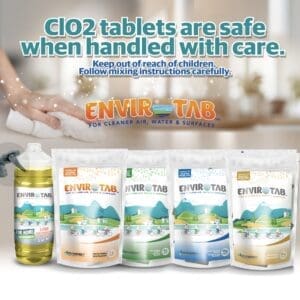Choose the 'No-Sodium' Cleaning Program
For decades, low- and no-sodium diets have been the cornerstone of conventional health advice. Doctors and nutritionists have long warned that excess sodium can raise blood pressure and increase the risk of heart disease. As a result, many people have come to view all forms of sodium with suspicion—often without distinguishing between harmful dietary sodium and beneficial forms found in non-ingested applications, like cleaning products. But when it comes to disinfectants like chlorine dioxide, it’s time to reconsider what “sodium” really means in context.
When people hear “chlorine dioxide,” they often assume it’s just another name for bleach. That couldn’t be further from the truth. While both contain the word "chlorine," chlorine dioxide (ClO₂) and sodium hypochlorite (bleach) are chemically distinct—and when it comes to safety, effectiveness, and sustainability, the difference is radical.
Let’s break down how these two disinfectants stack up.
1. The Chemistry: Similar Names, Very Different Substances
Bleach is made from sodium hypochlorite, a caustic, highly reactive solution. It releases free chlorine, which is both corrosive and unstable in storage.
Chlorine dioxide, on the other hand, is a neutral gas dissolved in water, with a completely different molecular structure. It doesn’t break down into toxic chlorinated byproducts the way bleach does—and it remains stable and effective without the harshness.
2. Effectiveness: ClO₂ Kills More, Kills Faster
ClO₂ is a broad-spectrum biocide. It destroys viruses, bacteria, mold, spores, and even biofilms with greater speed and at lower concentrations than bleach.
- ClO₂ kills pathogens like E. coli, Listeria, Salmonella, and Norovirus in under a minute.
- Bleach often requires longer contact times and higher concentrations—while losing effectiveness in the presence of organic matter.
3. Safety: ClO₂ Is Gentle on People and Surfaces
Bleach fumes can irritate eyes, skin, and lungs. When mixed with other cleaners (like ammonia), it can release toxic chlorinated gases.
ClO₂, especially when generated from tablets like Envirotab, is:
- Non-corrosive
- pH-neutral
- Safe for use in enclosed spaces
- Leaves no toxic residue
It's even used in drinking water treatment and hospital-grade disinfection, making it an ideal choice for homes, schools, healthcare settings, and food facilities.
4. Environmental Impact: ClO₂ Is the Clear Winner
Bleach degrades into carcinogenic trihalomethanes (THMs) and chlorinated organics. It harms aquatic life and contributes to indoor air pollution.
ClO₂ is eco-friendly:
- Breaks down into salt and water
- Does not form harmful chlorinated byproducts
- Requires less packaging, less volume, and lower transportation impact when used in tablet form like Envirotab
5. Convenience: Tablets vs. Jugs
Bleach comes in heavy, leaky, single-use plastic containers. It degrades over time, making long-term storage a problem.
Envirotab ClO₂ Tablets:
- Compact and shelf-stable for up to 3 years
- Activated on-site with water only when needed
- Safer to transport and store—no risk of spills or fumes
The Verdict: Bleach Is Outdated—ClO₂ Is the Future
If you're serious about green cleaning, bleach simply doesn’t belong in your program. It's harmful, unstable, and ineffective compared to modern solutions.
Chlorine dioxide is the sustainable choice. With Envirotab ClO₂ Tablets, you're not just cleaning better—you're cleaning smarter. You’re protecting your people, your surfaces, and the planet.
Say goodbye to bleach. Say hello to safe, powerful, eco-friendly cleaning.






